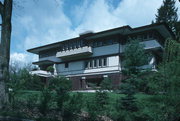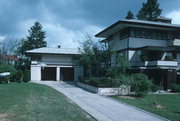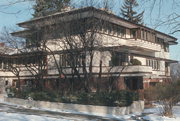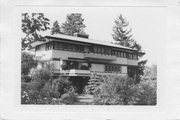Property Record
2914 OXFORD RD
Architecture and History Inventory
| Historic Name: | Josephine and Prof. Harold C. Bradley House |
|---|---|
| Other Name: | |
| Contributing: | Yes |
| Reference Number: | 5792 |
| Location (Address): | 2914 OXFORD RD |
|---|---|
| County: | Dane |
| City: | Shorewood Hills |
| Township/Village: | |
| Unincorporated Community: | |
| Town: | |
| Range: | |
| Direction: | |
| Section: | |
| Quarter Section: | |
| Quarter/Quarter Section: |
| Year Built: | 1916 |
|---|---|
| Additions: | |
| Survey Date: | 1980 |
| Historic Use: | house |
| Architectural Style: | Prairie School |
| Structural System: | |
| Wall Material: | Stucco |
| Architect: | George Elmslie and William Purcell |
| Other Buildings On Site: | |
| Demolished?: | No |
| Demolished Date: |
| National/State Register Listing Name: | College Hills Historic District |
|---|---|
| National Register Listing Date: | 12/9/2002 |
| State Register Listing Date: | 7/19/2002 |
| National Register Multiple Property Name: |
| Additional Information: | A 'site file' exists for this property. It contains additional information such as correspondence, newspaper clippings, or historical information. It is a public record and may be viewed in person at the Wisconsin Historical Society, Division of Historic Preservation. LAST LARGE RESIDENCE BUILT BY PURCELL AND ELMSLIE. These architects from the Twin Cities, one of whom, Elmslie, had worked with Louis Sullivan for many years, were leading practitioners of the Prairie style. Elmslie had a long working relationship with the Bradleys. In 1909, he had served as Sullivan’s draftsman and representative in the creation of the Bradleys’ first Madison home. Elmslie and William Purcell also designed a summer house for the Bradleys in Woods Hole, Massachusetts, one of the firm’s best-known works. Wanting their designs to harmonize with the surrounding environment, the firm sited this second house for the Bradleys in Madison to offer spectacular vistas of Lake Mendota, the University of Wisconsin campus, and the State Capitol. The house also evokes the Midwestern horizon line, using long ribbons of casement windows, wide-overhanging eaves, cantilevered balconies, and bands of wooden trim to produce a pronounced horizontality. Purcell and Elmslie also played with the viewer’s sense of space. From the street, the house appears to hover over the earth, its dark-brick raised basement a visual void beneath the white stucco walls. The stucco walls themselves seem like mere membranes, enclosing the volume of the house, something seen later in European modernism of the 1920s. Like many architects of the Progressive Era, Purcell and Elmslie embraced domestic-reform ideals. They experimented with making a house into “a perfect machine for accomplishing all the household life as automatically as possible” with the push of a button. Here they installed work-saving devices such as a central vacuum-cleaning system. They also focused on efficiency. As Purcell later observed, “the closets and storerooms were a maze of specialized subdivisions for every possible article,” and the kitchen “was a pioneer study in scientific arrangement.” Brock: "Harold C. Bradley was a professor of physiological chemistry and an enthusiastic outdoorsman. Bradley and his wife Josephine Crane Bradley established the Bradley Memorial Children's Hospital in honor of their daughter Mary Cornelia, who died tragically at the age of seven. Harold Bradley was also the founders if the Hoofers at the University of Wisconsin (there is a Harold Bradley memorial room in the Hoofers complex in the Memorial Union). The first Bradley house, designed by Louis Sullivan, was built in University Heights, but proved too large so the Bradley's decided to build another house in John McKenna's new College Hills suburb. The house was completed in 1916...the garage and the servants quarters were built in the 1920s. The original garage, near the front door, became a workshop. Although the College Hills house was smaller than the one in University Heights, it was still large for its day. Bradley made sure that the design included extensive sleeping porches, which were highly prized before air conditioning. The Bradley's eventually had six sons living in the house. The Bradleys originally owned all the land on the north side of Oxford Road from the top of the hill to University Bay Drive. Their tennis court was the first concrete court built in the state of Wisconsin/ Bradley built a small ski jump on his property for use by his burgeoning family, replaced in the 1920s by a larger one on top of the hill facing the school grounds." |
|---|---|
| Bibliographic References: | Buildings of Wisconsin manuscript. Thomas D. Brock, The Village of Shorewood Hills and Shorewood Hills Community League, Madison, Wisconsin, Historic Shorewood Hills: A Walking Tour of the Village, 1997. Madison Houses 1836-1915 by Jill Moore Marx Perrin, Richard W. E., Historic Wisconsin Architecture, First Revised Edition (Milwaukee, 1976). A Celebration of Architecture: Wisconsin Society of Architects Tour of Significant Architecture, 1979. |
| Wisconsin Architecture and History Inventory, State Historic Preservation Office, Wisconsin Historical Society, Madison, Wisconsin |





